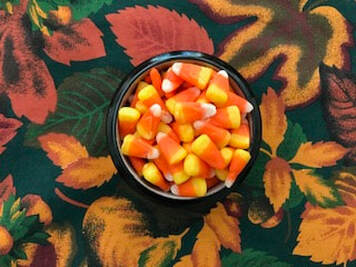Candy Corn's Haunted History
|
Candy Corn, an iconic Halloween treat, has a long and occasionally dark history. Like chocolate bars, marshmallows, and other familiar sweets, candy corn was a product of the 19th century.
Its first manufacturer, Wunderle Company, called the treat “chicken corn.” In 1898 Wunderle sold the recipe to the Goelitz Confectionery Company, later renamed Jelly Belly. Goelitz mass-produced and marketed the candy as “chicken feed” in boxes with a picture of a rooster and the slogan: “Something worth crowing for." Growing up as baby boomers, my friends and I called the treat chicken feed. Other manufacturers made tricolor bits shaped like corn kernels with little variation from the original recipe, but didn't call them chicken feed. |
1950 was a bad year for candy corn. The treat's glossy appearance comes from the confectioner’s wax used as an ingredient. On Sept 9, 1950, a wax-lined kettle caught fire at the Goelitz candy factory in Midland Park, New Jersey. The fire consumed the block-long factory building and burned for days near a residential neighborhood. Because burning candy makes a really hot fire, people had to hose down their houses to keep them cool. The factory workers emerged safely, but 2,000 or so pounds of candy corn perished in the inferno. With the factory destroyed, Goelitz could not fulfill all its candy corn orders in time for Halloween. Its competitors, like Brachs, stepped up their production to meet the demand. Brachs and Jelly Belly remain the leading producers of candy corn today.
The factory fire wasn’t the only calamity involving candy corn that year. An article in Slate by Deborah Blum, author of The Poisoners Handbook, describes what happened to those who over-indulged in Halloween sweets in 1950. After eating candy corn, mellow cream pumpkins, and popcorn balls, children across the country exhibited rashes and gastrointestinal problems. Investigators concluded that the problem was with the dye that went into those products. Orange Dye No. 1 had been approved in the early 20th century and used liberally in candy, cakes, soft drinks, and even hot dogs for decades. But after the 1950 Halloween incident, the FDA investigated that dye and other coal-tar dyes, concluded they were toxic, and removed them from the approved list. Safer dyes are now used in candy and other processed food. So the candy corn calamity has a happy ending.
|
Halloween-themed culinary mysteries often feature candy corn on the cover, and 6th Five-Ingredient Mystery, Crypt Suzette, is no exception.
As Val caters a Halloween party at Bayport’s bookshop, a group of would-be writers, the Fictionistas, compete in the costume contest. One of them, the secretive Suzette, rents a spare room from Granddad. When she’s found dead after a hit-and-run, the Fictionistas accuse one other of murder. Did one of them kill her or was her death rooted in the past she’d worked hard to escape? Val and Granddad must pull off a Halloween ruse to rip the mask off a murderer. "Granddad is a hoot to live with, and his jobs as a food reviewer and part-time detective provide endless possibilities for fun and murder." -- Kirkus Review of Crypt Suzette Read more about Crypt Suzette. |
"Candy Corn's Haunted History" appeared originally on Mystery Lovers' Kitchen, where I blog with other writers of culinary mysteries.

